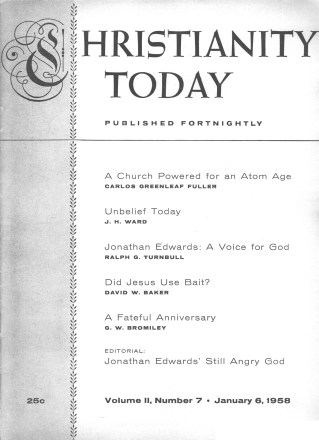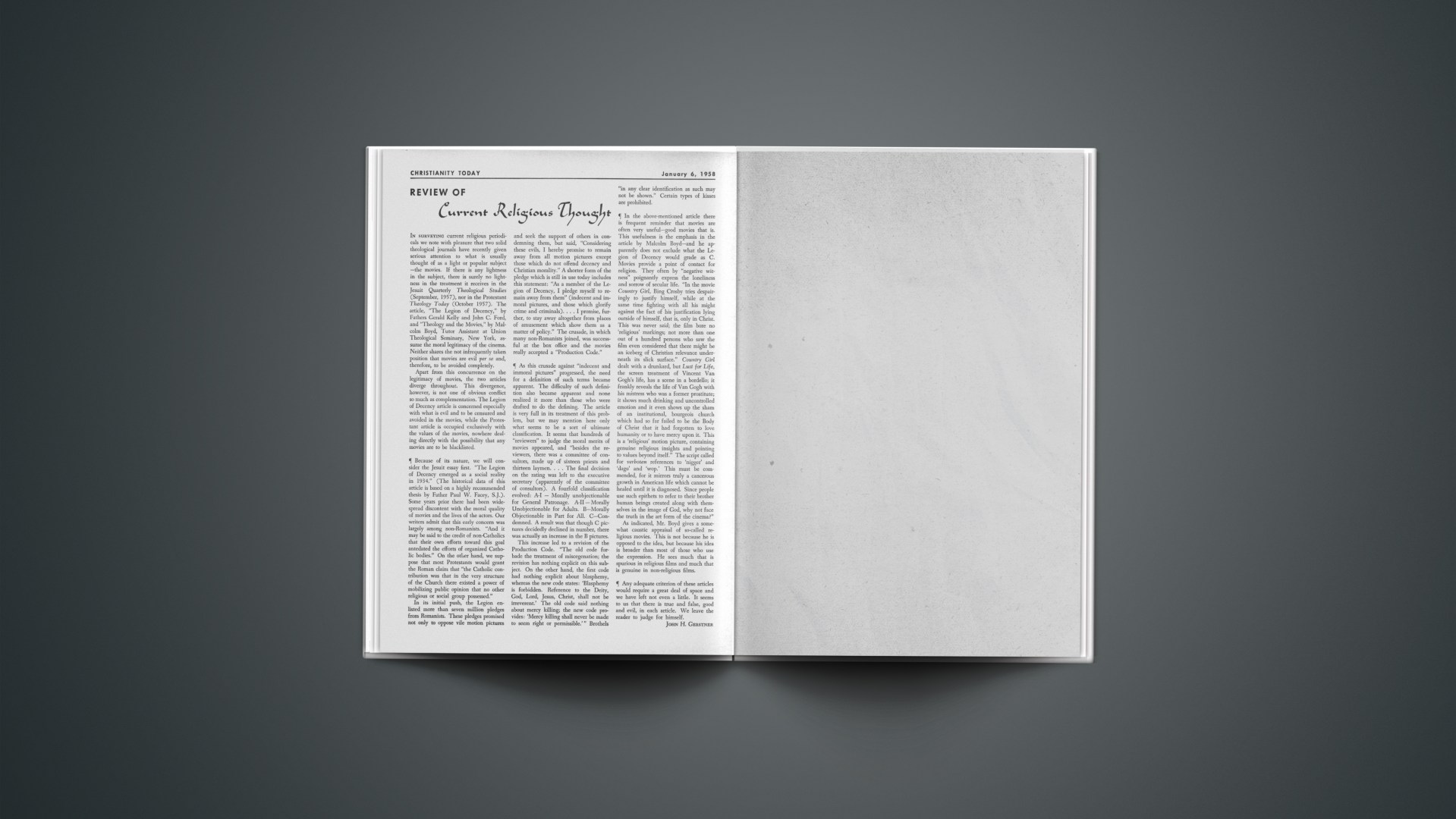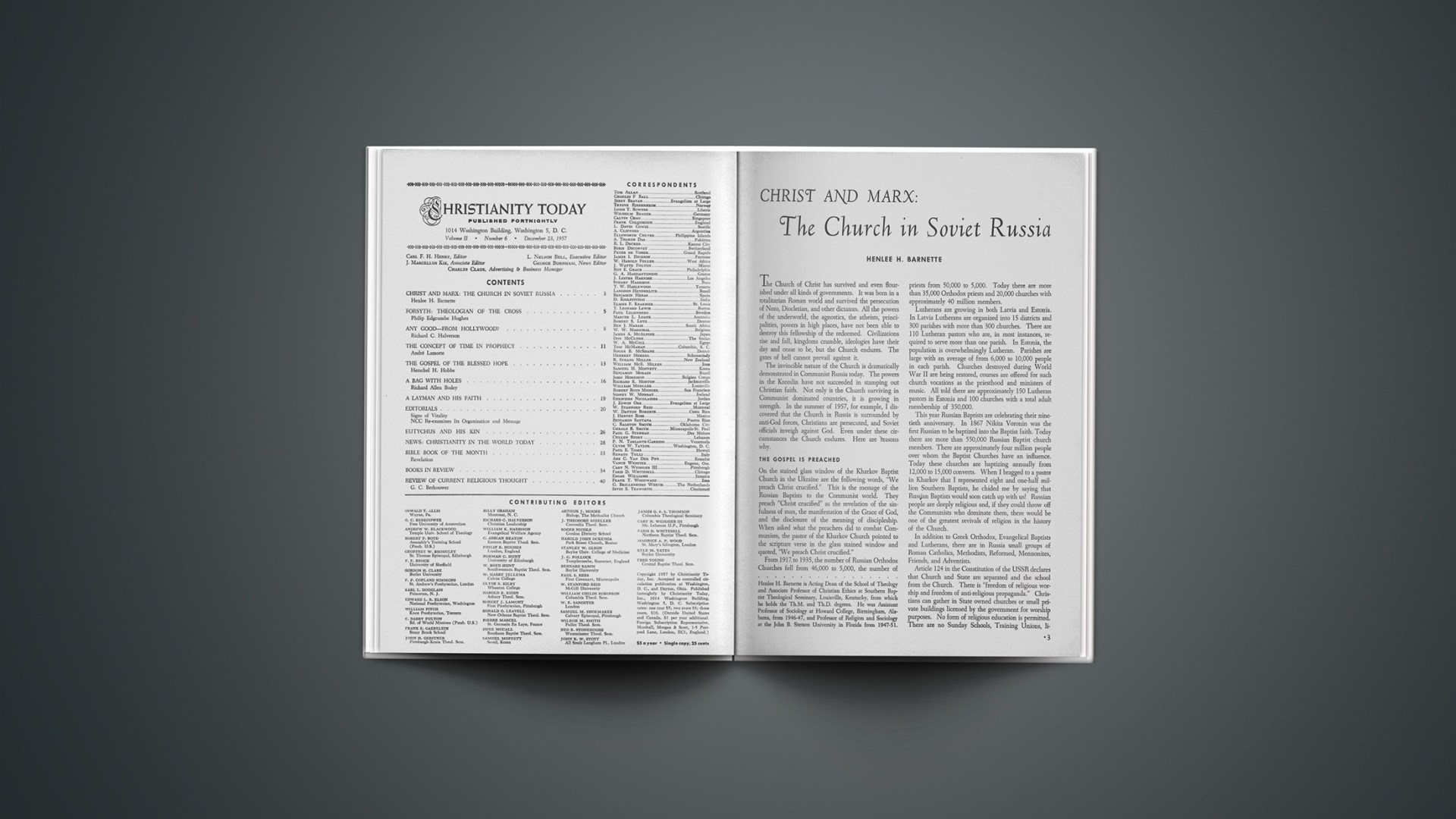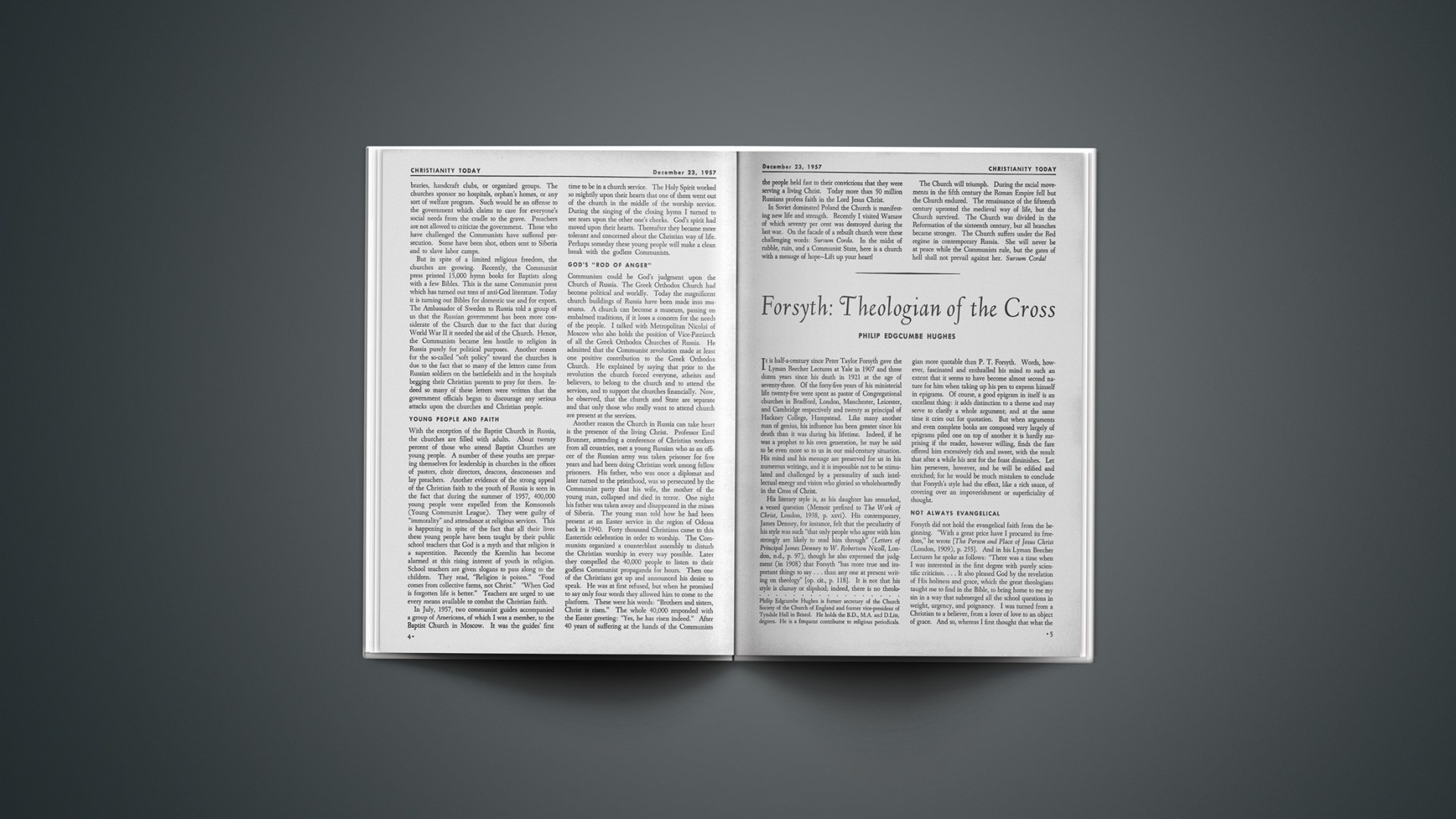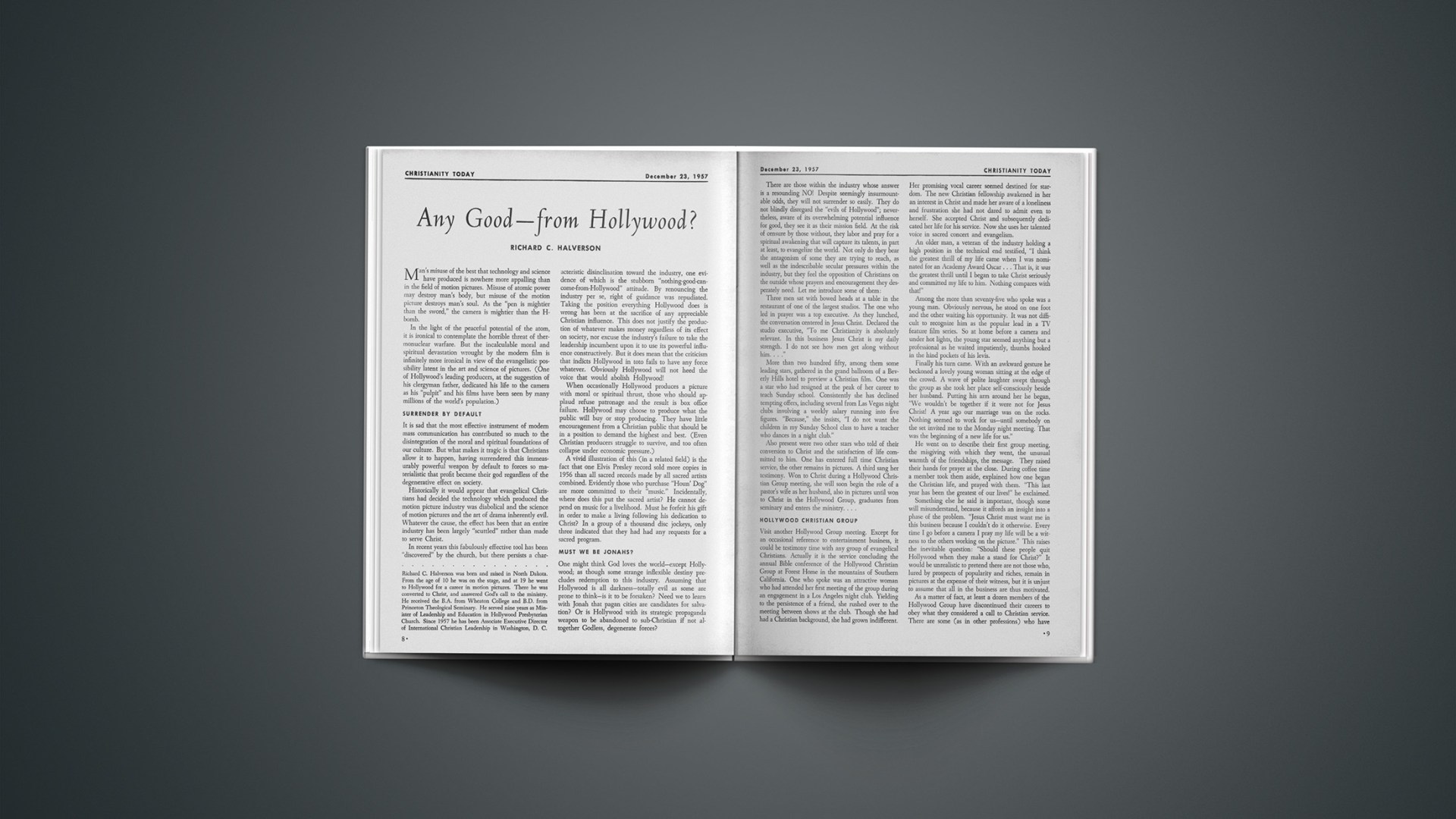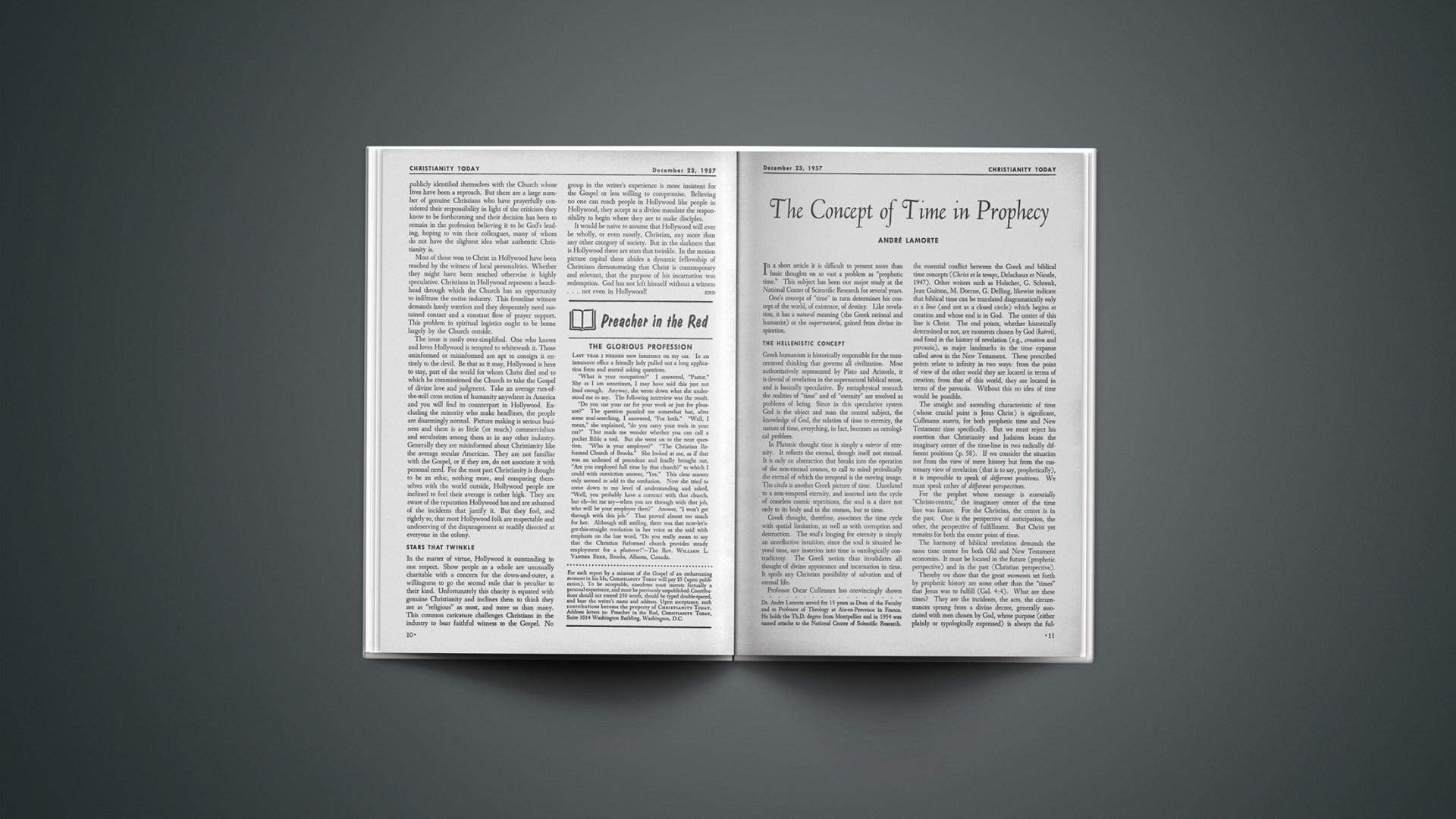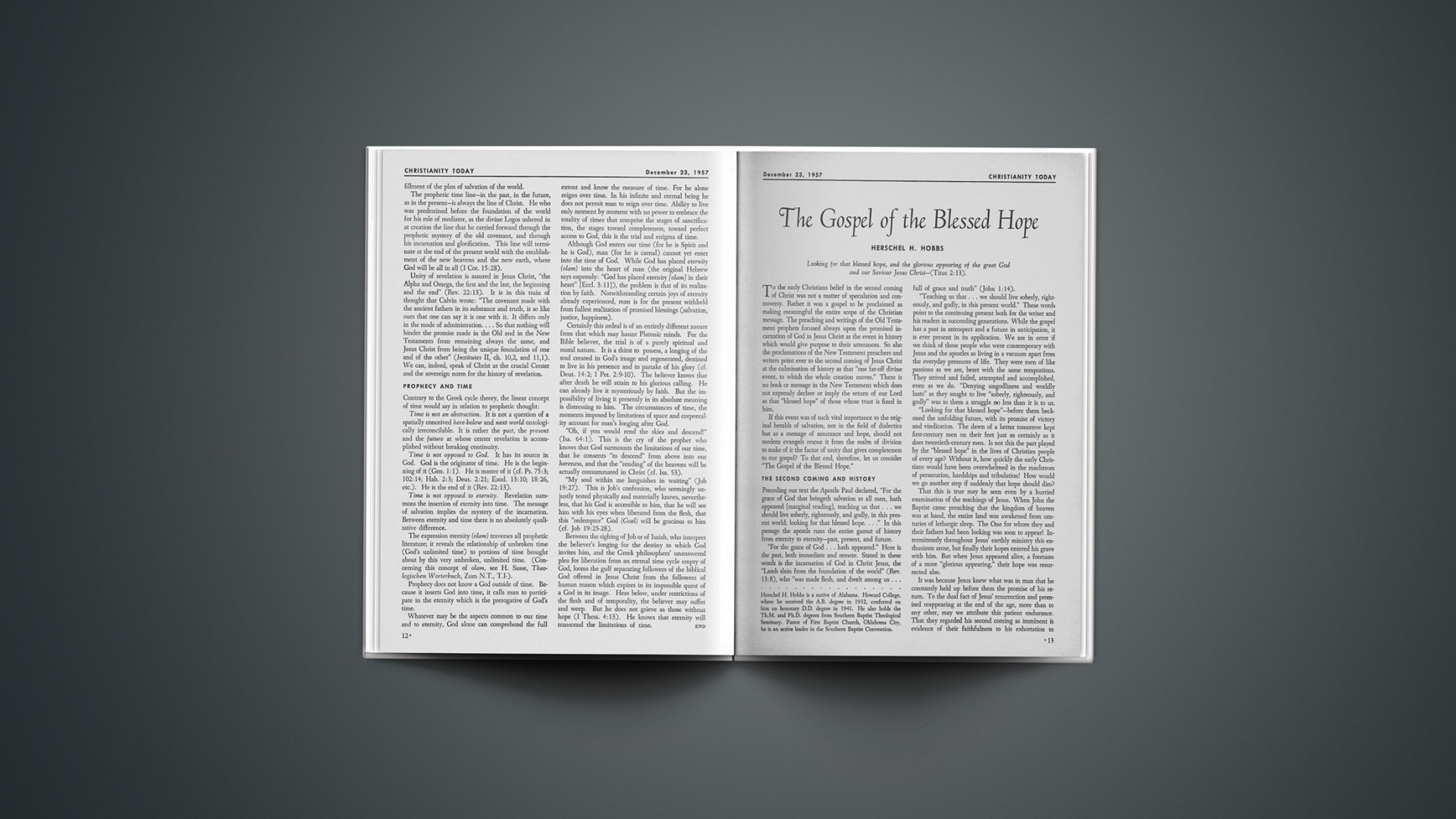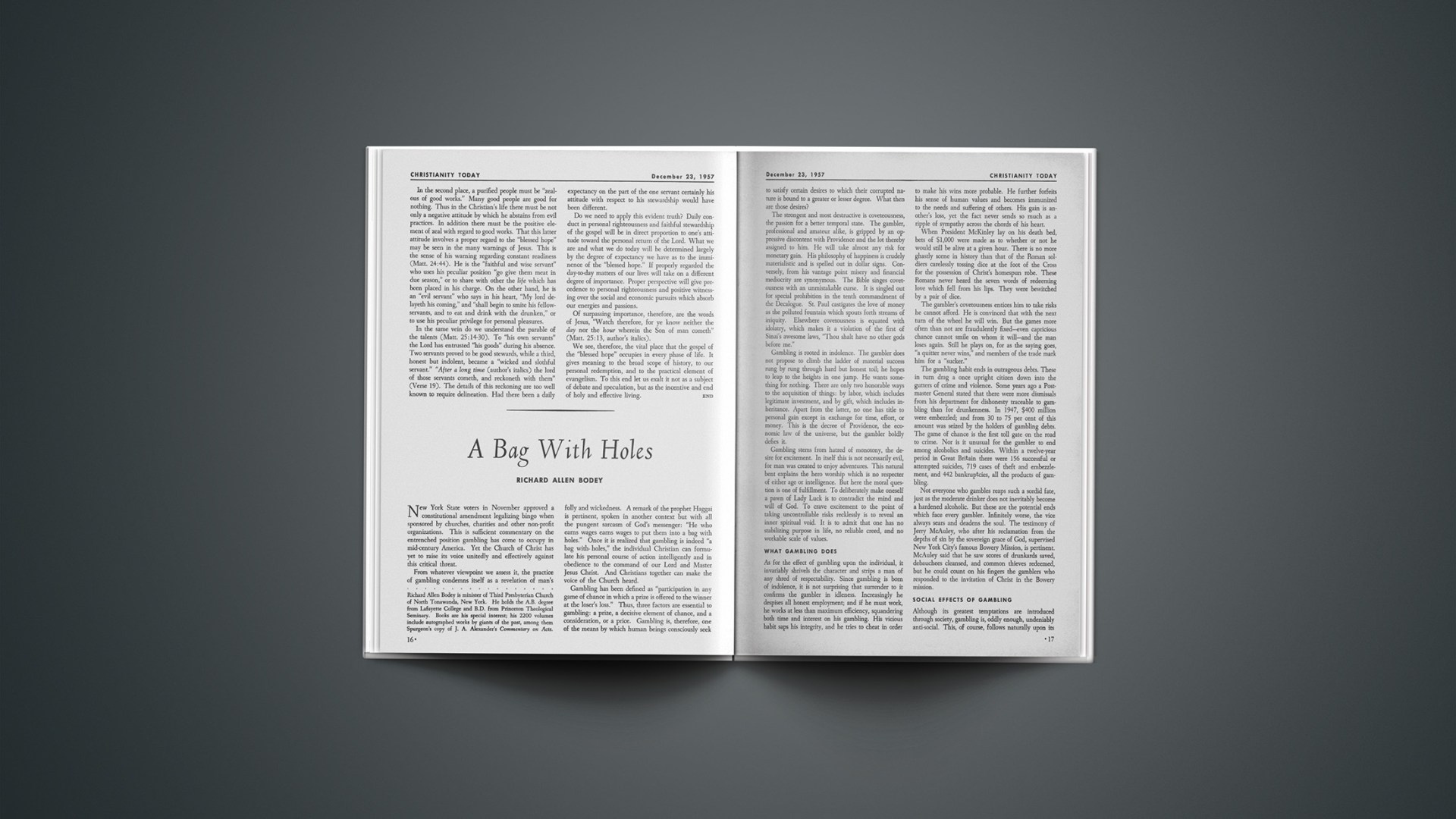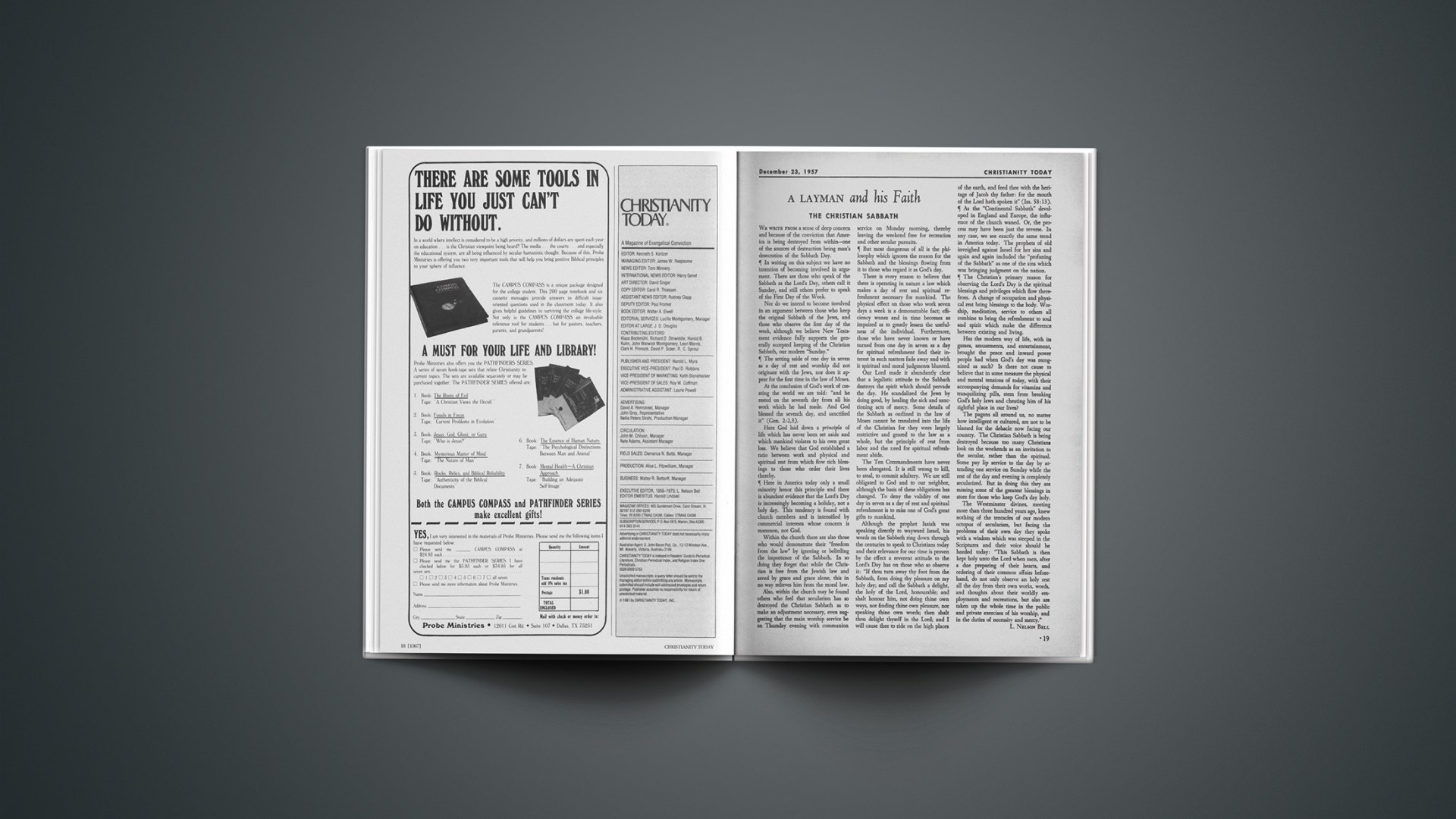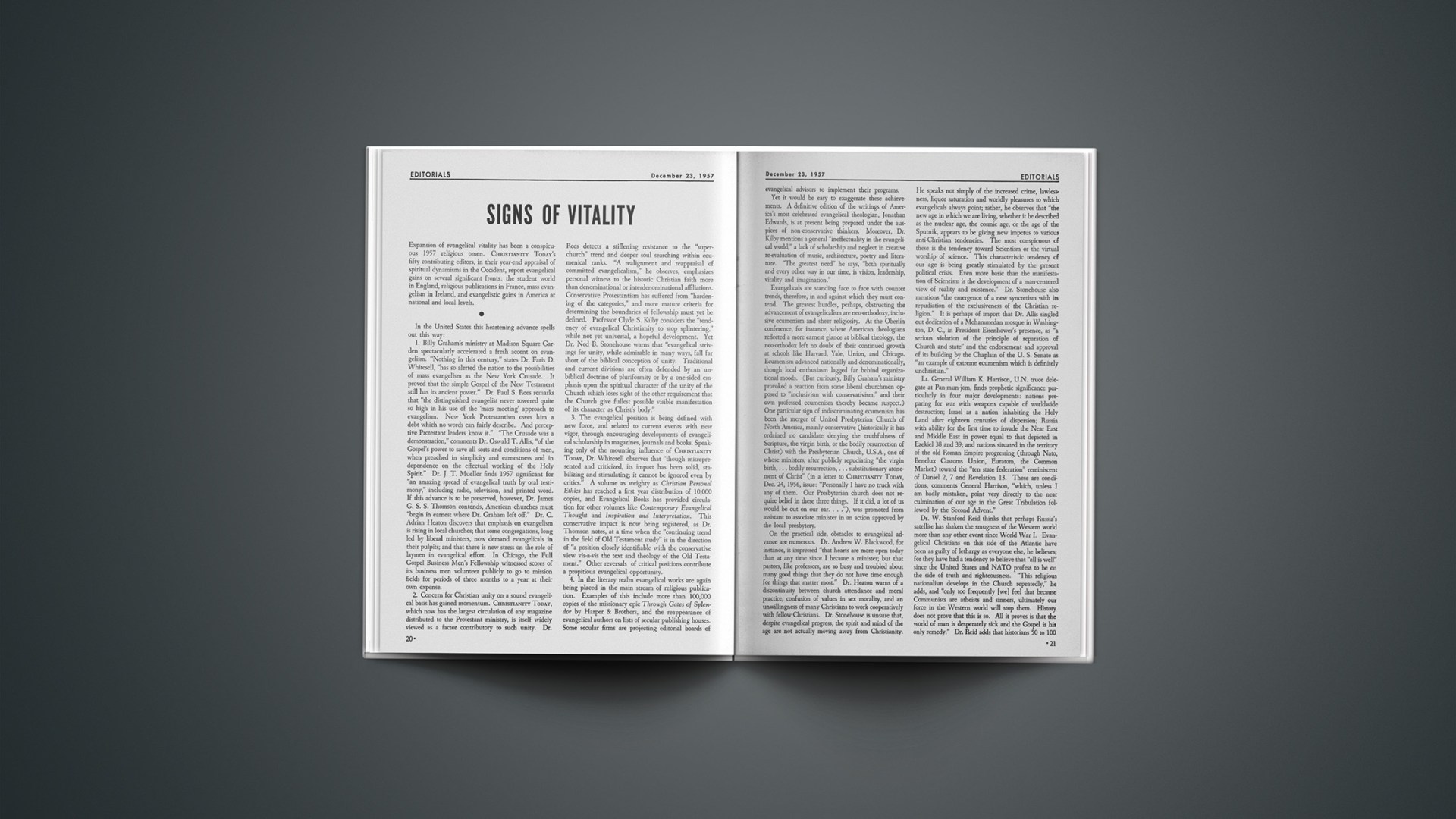Biblical Perspective
The Secret of Radiant Life, by W. E. Sangster, Abingdon, 1957. $3.00.
The author, formerly minister of Westminster Central Hall in London, has a large following on both sides of the Atlantic. He will endear himself to many more who meet him for the first time on these pages.
“The Secret of Radiant Life” is a volume long overdue. For some time Americans have stormed the book stands for a wide variety of selections on The Art of Happy Living and kindred themes. In most instances they have been sold short by promoters of the “Do It Yourself” Cult. Dr. Sangster writes on this subject from a perspective which is manifestly and refreshingly biblical. He rightly emphasizes that the radiant life is not the crowning accomplishment of human effort but the mind of Christ achieving itself anew in human personalities. It is therefore a gift of divine grace communicated to the believer by the indwelling Holy Spirit. Yet it is not automatically conferred. While man cannot manufacture it, he nevertheless must exercise conscious effort in the direction of a total surrender of his whole being. “To have the mind of Christ we must give him our mind.”
In addition to theory there are practical suggestions and meditations here which aid in a fuller appropriation of the mind of Christ. The reader will find among these meditations some novel methods of prayer and Bible study which will remove the dullness and drabness from his own routine.
One further emphasis is worthy of note. The author warns that if the mind of Christ is sought selfishly the quest will end in disappointment. The grace is given only to be shared. It is poured, not into reservoirs, but into living channels.
We recommend Dr. Sangster’s book universally because it is rooted in the biblical concepts of sin and grace and because it is eminently useful in enriching the life of Christians.
RICHARD ALLEN BODEY
Sane And Sound
The Dead Sea Scrolls, by Charles F. Pfeiffer. Baker Book House, Grand Rapids. $2.50.
Here is another useful introduction to the Dead Sea Scrolls. All who write on this subject are much indebted to the legion of their fellow scroll enthusiasts and Dr. Pfeiffer, a recent graduate of the Dropsie College of Hebrew and Cognate Learning and now Professor of Old Testament Language and Literature at Moody Bible Institute, exhibits commendable modesty in acknowledging his debts, especially to Millar Burrows’ The Dead Sea Scrolls.
All the ground is covered in this survey—the story of the discoveries, the Qumran community, the contents of the scrolls, the questions of their date, historical background and their relevance for biblical studies and Christian origins. The over-all treatment is uneven, however (42 of the approximately 92 pages of text are devoted to the chapter on “The Sectarian Scrolls”) and, therefore, the discussion of some matters is exceedingly brief. In style the presentation is somewhat encyclopedic—in contrast, for example, to F. F. Bruce’s volume which carries the reader along more lightly over about the same terrain.
The author achieves his stated aim of presenting an “objective and dispassionate” survey of the scrolls and their significance. He labors no particular thesis. Making his way through the many knotty problems he repeatedly succeeds in laying his finger on the decisive point, yet states his conclusions with scholarly restraint. In gauging the significance of the scrolls for biblical studies Pfeiffer is sanely conservative and his judgments on the relevance of the scrolls for Christianity are theologically sound—and that is a welcome change from much of the mushrooming literature on this subject.
MEREDITH G. KLINE
Religious Fire
The Great Awakening in New England, by Edwin Scott Gaustad, Harper, 1957. $3.00.
Here is a careful study of the Great Awakening—a religious fire which swept the American colonies in the 1740’s. The author limits his study to the Awakening in New England, but this phase is of profound importance for understanding the spread and character of Christianity in the entire United States.
Gaustad’s book on the Great Awakening (his first published work) is not an exhaustive chronicle or detailed narrative. The main figures and phases of the Awakening are introduced, but they pass in brief review and only when they are relevant to the author’s thesis. One must look elsewhere for a closer introduction to Jonathan Edwards, George Whitefield, Gilbert Tennent and Charles Chauncy. But, as it stands, this new survey is a first-rate appraisal of an important event in American history; no student of its church history can afford to neglect it.
The Great Awakening in New England was at its peak in 1741–42. In the first chapter, Gaustad sketches the Puritan background; in the following four chapters he gives highlights of the revival’s rise and fall, and the three final chapters indicate three consequences of the Awakening—personal, institutional and theological.
Exception may be taken to the statement on page 85 that Yale College was “the coldest, darkest corner of New England” in Great Awakening days. New Haven may not have known the excitement that swept through a place like Northampton, but there must have been far “colder, darker” corners. Witness the effect that the revival had on New Haven and Yale—church attendance surged, trustees were hard put to keep things running normally at Yale College, and the visits of Whitefield, Tennent, and Edwards produced no small stir. Indeed, it was at Yale that Samuel Buell was aroused to his provocative ministry as an itinerant evangelist, that David Brainerd was inspired to go from room to room in students’ quarters to confront classmates with the demands of faith and repentance, and that Samuel Hopkins—himself destined to become one of Edwards’ most influential followers and New England’s first systematic theologian—was brought to conversion. Surely, this could not have been in New England’s “darkest, coldest corner.”
The book would be stronger if more space had been devoted to showing the connection of the revival to subsequent developments in American Calvinism, to the Harvard-Yale-Andover-Hartford series of events which led at last to the repudiation of New England Theology and the acceptance of theories based on higher critical, evolutionary and rationalistic hypotheses.
DICK L. VAN HALSEMA
Christ Not Marx
Marx Meets Christ, by Frank Wilson Price, Westminster, Philadelphia. $3.50.
In the judgment of this reviewer this is the finest book yet written on the conflict between Communism and Christianity. Dr. Price does not write from theory, from unsupported opinions or from an unreasoned prejudice; rather he has read and digested Marx’s writings, has seen his theories put into practice, compared the man Marx with the Lord Jesus Christ, Communism with Christianity, and come up with the most incisive and devastating analysis it has yet been our privilege to read.
Marx Meets Christ is divided into four sections: I. Two Persons Meet; II. Two Ideas Meet; III. Two Systems Meet; and IV. Two Faiths Meet.
With some of the views expressed by Dr. Price we do not concur, particularly his rather obvious feeling that the ideal government towards which Christianity should work is some form of modified socialism. There are various countries today in which one may study modified socialism but in every case the nation has emerged in a weakened state and its people with security bought at too great a price.
Having made these reservations we go on to say that in repeated comparisons Dr. Price comes out clearly and unequivocally for the triumphant and living Christ and convicts Marx on every count. In fact, this book has more voluminous quotations from the writings of Marx, with incisive refutations accompanying them, than any other book of comparable size we know of. In addition, the actual applications of Communistic principles and the techniques employed and the results attained are shown up in the refreshing light of immediate effects and eventual by-products, so much so that readers with any possible illusions as to the usefulness of Communism should have them dispelled once and for all.
In Section II, “Two Ideas Meet,” we read:
Marxism would change systems, then mass man; Christianity seeks to transform both individual men in their societies and, through them, the systems and structures of society.… Communistic violence turns the sword first against the enemy class (everyone except the workers); Christian love turns the sword first against evil in oneself. Christ was sure that the gentle, brave, and loving would possess the earth rather than the fierce, cruel and hateful (p. 74).… Marx’s faith that a new social system will automatically change all human nature in it from greed to cooperation, from parasitism to hard work, from evil to good, is a naive, unscientific, and, we add, unchristian view of the nature of man (p. 77).… Jesus Christ gave men a social hope for this world and for the world to come, partial hope for this age of history and a perfect hope for history beyond history. The Kingdom of God—the rule of God—is being realized in measure now and could be realized far more; but it is Christian realism to admit that it can never be fully realized in space and time as we mortals know them (p. 78).
Section III, “Two Systems Meet.” Dr. Price repeatedly states the only too often overlooked fact that Communism never changes in its ultimate objectives. For tactical purposes there may be retreats and flank movements.
From time to time Communist leaders enlarge the area in which they will maneuver and thus make it somewhat easier for other groups to deal with them (we are in such a period today), but never has there been any serious deviation from basic theory or from main lines of strategy that the Communistic power bloc deems essential to its present and future interests (p. 94).
One startling statement is found with reference to the absolutism within the Communist system:
It is more difficult to join the Communist Party today than to join a Christian church body. For this reason the number of fellow travelers far exceeds the actual registered membership in Communist parties. With all of this voluntary, enthusiastic assistance, the Communists are able to move swiftly into political vacuums.… Even peoples who love liberty do not realize how much a Communist government that brings certain reforms can crush that liberty. The Chinese people today are a vivid illustration.
Dr. Price brings out the exceeding dangerous cleverness often exhibited by the Communists: “The means that the Communists select are generally clever, diabolically clever, and at times frighteningly efficacious” and this is because they are “not inhibited by any personal compunctions, democratic ideals, or religious standards of the non-Communistic world” (p. 96). Speaking of their strategy Dr. Price tells how they exploit situations, attach their cause to popular movements and legitimate national aspirations and even use religion and religious ideals as a cover for Communist efforts. He tells of their infiltration and subversive activities, their zigzag tactics, their propaganda methods through highly trained professionals, their seizing of all media of public information when possible: “Those who have lived always in countries with relative freedom of thought can hardly understand the demonic force and hypnotic influence of Marxian ‘advertising’ ” (p. 120).
Section IV, “Two Faiths Meet.” This is clearly expressed in these words:
But Marxism is also a faith-inspiring creed, in a sense a perversion of Christianity, a twisted plagiarism from the Bible; in another sense a violent reaction against Christianity and return to pagan religion. Or we may call it a new humanitarian religion in which the deification of man has followed the denial of God (p. 136).… It is impossible, or next to impossible, to be a member of the Christian Church and the Communist Party at the same time (p. 139).
To read Marx Meets Christ is to realize afresh that it is Christ, not Marx, who has the answer to the individual and corporate needs of all mankind.
L. NELSON BELL
Heritage Piece
The “Old Colony” of New Plymouth, by Samuel Eliot Morison, Knopf, New York, 1956. $3.50.
This is a wonderful book by one of America’s great modern historians, who, perhaps in this book more than in any of his other 24 volumes, has displayed his gifts as a superb storyteller. The story he tells is old and familiar: the coming of the Pilgrims to Plymouth in 1620. But with what artistry he tells it, and with what fascinating new detail, and with what aliveness and simplicity! No wonder the Thomas Alva Edison Foundation has already given it its Annual Children’s Book Award “for special excellence.”
Of special note is the high spiritual tone with which this book begins and continues to its very end. There is no muckraking here, no debunking. Nor does the author indulge in the sentimental vagaries and half-truths of blind hero worship. One gets the definite impression that the early Pilgrims were seriously and soberly set upon the business of being just that: Pilgrims. And the deep faith which inspired them to begin their venture, and sustained them through it, shines through with great clarity.
In many respects Plymouth Colony was the most balanced of all the English colonies in New England, never knowing the extremes of Massachusetts Bay, Rhode Island, or New Haven. And Professor Morison has given us and our children such a readable and balanced account of Plymouth, and such an astute evaluation of what America owes to it religiously and politically, that one lays down his book with much reassurance that the foundation of the American way of life was good. In its remembrance and in the continuation of the spirit and faith in which it was established lies our national hope.
DAVID W. BAKER
Literary Work
Newman: Prose and Poetry, selected by Geoffrey Tillotson, Rupert Hart-Davis, London, 1957. 30s.
Quite apart from being one of the most controversial figures of last century, John Henry Newman was a master of fine English prose. In this fat and excellently produced volume (one of the Reynard Library series of reprints) Mr. Geoffrey Tillotson has not given us an anthology, but instead has brought together some of Newman’s longer works in extenso, in particular the propagandist novel entitled Loss and Gain, the Discourses on the Scope and Nature of University Education and the History of My Religious Opinions (better known as the Apologia pro Vita Sua). Added to these there is The Tamworth Reading Room, selections of four sermons and eight letters and a number of verses. In view of the great amount of material available one cannot help feeling that, with the exception of the Apologia, something more in the nature of an anthology would have been preferable; and surely Newman’s letters could with advantage have played a more prominent part in a volume of this nature. It is entertaining to find one so intimately bound to Oxford as Newman was writing in one of these latter, with reference to a visit to Cambridge: “My allegiance to Oxford was shaken by the extreme beauty of this place.” In another he confesses that the only master of style he ever had was Cicero.
To read Newman’s Apologia again after an interval of a good many years is a forcible but also fascinating reminder of the mental and psychological tortuosities of this strange and somewhat pathetic cleric. Though brought up in an Evangelical home, even as a child he was very superstitious and, until an experience of conversion at the age of fifteen, used constantly to cross himself on going into the dark. Of Hurrell Froude, John Keble’s pupil and friend, he says: “He taught me to look with admiration towards the Church of Rome and in the same degree to dislike the Reformation. He fixed deep in me the idea of devotion to the Blessed Virgin, and he led me gradually to believe in the Real Presence.” A visit to Rome, including two calls on Cardinal Wiseman, in 1833 convinced him that he had “a work to do in England.” Having grown up with the belief that the Pope was Antichrist, Newman was coming to embrace a very different opinion. The desire to reconcile Romish dogma with the teaching of the Thirty-Nine Articles led up to the publication, in February 1841, of the notorious Tract 90. “Alas!” he exclaims, “it was my portion for whole years to remain without any satisfactory basis for my religious profession, in a state of moral sickness, neither able to acquiesce in Anglicanism, nor able to go to Rome.” The Via Media of Anglo-Catholicism failed to satisfy the hopes he had entertained of it. Then in 1843 he took “two very significant steps”: in February he made a formal retractation of all the hard things he had previously said against the Church of Rome; and in September he resigned the living of the University Church of St. Mary’s at Oxford. At last, two years later, there came his expected desertion of the Church of England for the Roman allegiance. What “Kindly Light” led him amid that “encircling gloom” it is difficult to imagine. (The famous hymn, incidentally, contrary to popular misconceptions, had been written years before, in 1833.)
“The things chosen are among those which most obviously interest the general reader,” explains Mr. Tillotson in his Introduction, “but it would be wrong to consider them as more literary than those I have passed over”; indeed, as he goes on to point out, “Newman is always literary, even, all things considered, when he is most narrowly ecclesiastical.”
PHILIP EDGCUMBE HUGHES
New Testament Church
Israel and the New Covenant, by Roderick Campbell, Presbyterian and Reformed, Philadelphia. $3.75.
The early chapters of this book set forth the position, privileges and blessings that accrued to Old Testament Israel under the Abrahamic and Sinaitic covenants, and the much greater blessings which under the New Covenant accrue to the Christian Church. The promise spoken through the prophet Jeremiah was: “Behold, the days come, saith Jehovah, that I will make a new covenant with the house of Israel, and with the house of Judah.… I will put my law in their inward parts, and in their hearts will I write it; and I will be their God, and they shall be my people” (31:31–34).
This New Covenant, our author says, was established by Christ with the “faithful remnant” among the Jews who recognized him as the long promised Messiah and as the rightful King of Israel. This group became the nucleus of the New Testament Church, the true and lawful successor of Old Testament Israel, and as such the rightful heir to all of the unfulfilled prophecies and promises that related to Israel.
In harmony with Paul’s statements that, “They that are of faith, the same are sons of Abraham,” and, “If ye are Christ’s, then are ye Abraham’s seed, heirs according to promise” (Gal. 3:7, 29), the true Israel is no longer composed of the Jewish people as an ethnic group, but of all true believers in Christ. The writer affirms that the task assigned to the Church in the Great Commission is that of winning the entire world for Christ, and that that task can be accomplished during the present age with the means now at the disposal of the Church, namely, through the preaching of the Gospel and the regenerating work of the Holy Spirit. He refers to “those bright promises of world-wide salvation which sparkle like stars in the firmament of Holy Writ.”
The Church is represented as not yet having taken seriously the command to go and evangelize the whole world, nor as having in any adequate way laid hold on those resources that God has placed at her command. Instead, she is seen as ignoring the plainly stated fact that Satan is already a defeated foe, that he is “on a chain,” and that he can do only what he is permitted by God to do. The viewpoint of the book is therefore post-millennial.
The author’s treatment of the subject of prophecy is particularly enlightening. Chapter 8, entitled “Coming in the Clouds,” gives many helpful insights regarding the interpretation of Matthew 24, a portion of Scripture that has caused the commentators no little trouble. Much of the discussion moves within the realm of eschatology.
This is a worthwhile book. The author is well read, and he writes as an authority in his field. The reader gains a much clearer knowledge of God’s dealings with his people in all ages, and feels himself uplifted and edified as he peruses these pages.
LORAINE BOETTNER


